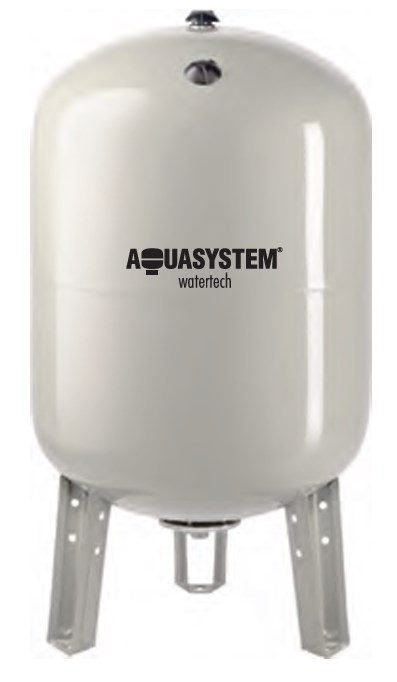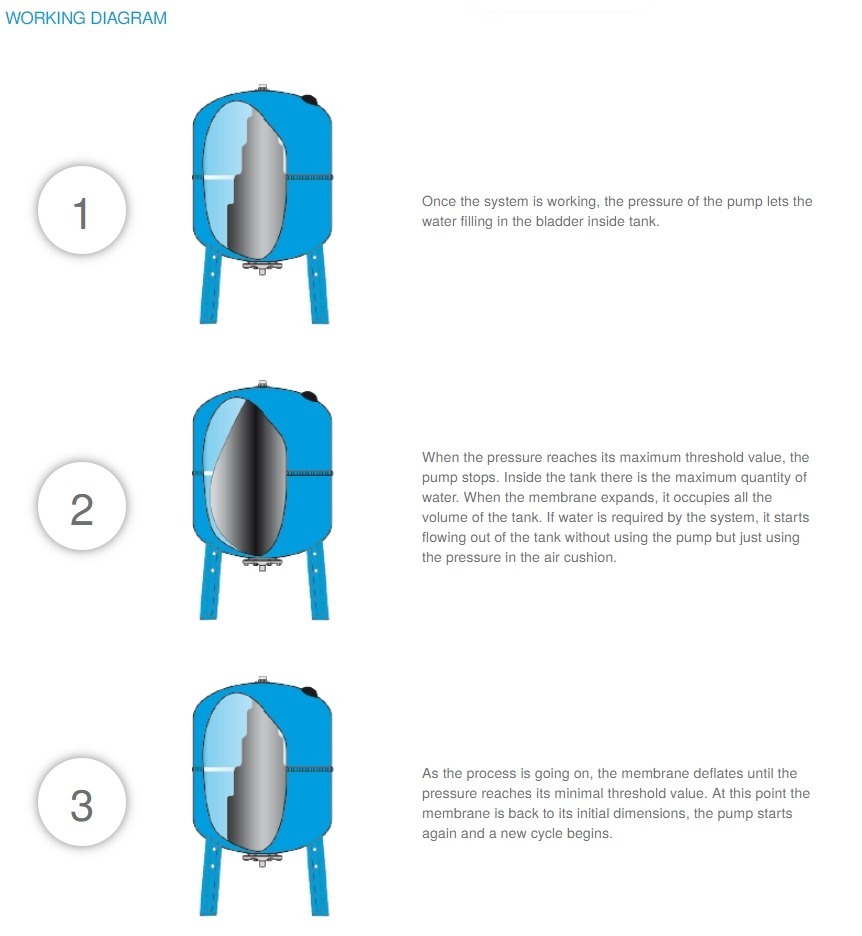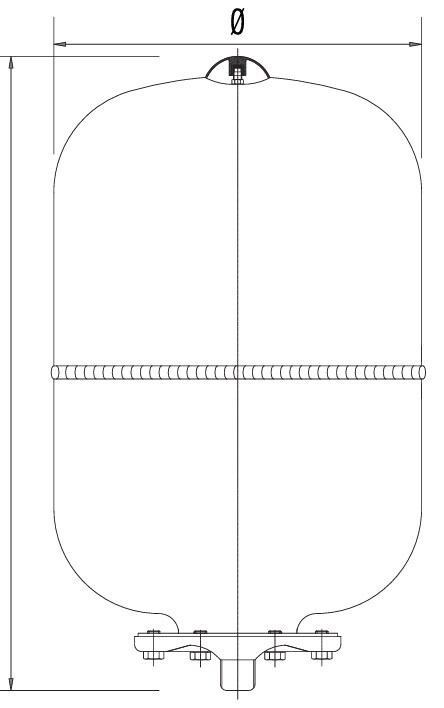Your cart is currently empty!
Aquasystem AVR80+ Hydropress tank 80 l
422,28 €
Extra heavy-duty BUTYL PLUS® membrane and all surfaces are covered with a corrosion-resistant epoxy polyester coating.
5 years warranty.
If you are looking for a pressure tank with a long lifespan and good performance, AQUAPLUS+ is a good choice.
The membrane of the tank is made of the innovative and patented material BUTYL PLUS®, which is characterized by outstanding resistance to osmosis as well as increased flexibility and durability.
The replaceable membrane is placed in production after the tank has been painted and cured in an oven, which prevents deterioration of the membrane’s properties.
The tank flange is made of stainless steel AISI 304. The surface is covered with a corrosion-resistant epoxy polyester coating.
Aquasystem AQUAPLUS+ tanks are WRAS® and ACS certified for drinking water and KOSHA certified.
TheAQUAPLUS+ tank seriesis covered by a 5-year warranty.
Pump bracket on top of the tank
Expansion vessel for use in sanitary heating/cooling systems, suitable for almost all domestic water systems and garden pumps.
This pressure vessel is supplied including replaceable EPDM membrane.
The pressure tank is designed for a maximum pressure of 10 bar and is supplied in a horizontal position
It has a 1 inch connection (32.89-33.25 mm)
AQUASYSTEM pressure tanks have an integrated valve to inflate the EPDM membrane (replaceable, suitable for drinking water).
The membrane is food grade EPDM material and is easily replaceable which is great!
Volume 80 liters
Diameter. 415 mm
Height 856 mm
Max temp. 100 `c
Max. pressure 10 bar
Test pressure 15 bar
Connection 1″
Pre-pressurized with 2.5 bar
Installation
It is imperative that the system is flushed to remove any contaminants that may damage the diaphragm before the vessel is put into service.
If a vessel is to be replaced in an existing system, it is important to start by disconnecting the power at the pump control panel and closing the shut-off valve or draining the system.
Check the pre-pressure of the vessel using a suitable air pressure tester; the pressure should be 0.5 bar below the cut-in pressure. The system pressure is read on the pressure gauge, which should be mounted as close as possible to the vessel.
Use a complete valve kit (ordered separately) that also includes a safety valve. The opening pressure of the safety valve must be no more than the working pressure of the vessel or lower, if the system pressure is lower.
Before putting the vessel into operation, perform the following:
Check that the vessel is correctly installed.
Start the pump and fill the vessel until the pressure switch automatically turns off the pump.
Open and close the tap furthest away from the vessel repeatedly to remove the air in the pipes.
Open one or more taps to empty the vessel.
If there is a pause between starting the pump and emptying the vessel, it is necessary to increase the working pressure of the pressure switch or reduce the pre-pressure in the Hydropress.
When the above points are completed, the system is ready to be put into operation.
Replacing the diaphragm
Disconnect the power at the pump control panel and drain the water from the system. Remove the vessel from the system and bleed using the pre-pressure valve. Unscrew the screws and remove the counterflange.
Unscrew the nut, which is on the other side of the tank and holds the
membrane.
Remove the old membrane from the membrane holder.
Insert the holder into the new membrane and insert the whole assembly into the tank through the flange hole, push the membrane holder out through the grommet on the top of the vessel and attach the membrane neck to the flange.
Reassemble the counterflange using the screws. Screw back the nut on the other side of the tank. Fill with air to 1.5 bar.
Function
A hydropress works on the same principle as a hydrophore, i.e. a pressurized water tank that serves as a store of pressurized water to which a pump is connected.
In this way, a pressure is created in the water pipes which will vary between the set pressure for the on and off switching of the pump.
This means that the pump does not start every time a water tap is opened.
A hydropress instead has a rubber membrane between the water and the air.
In a hydropress, the air side of the membrane is “pre-pressurized”.
The hydropress only needs to be about half the volume of a hydrophore.
Product details
Extra heavy-duty BUTYL PLUS® membrane and all surfaces are covered with a corrosion-resistant epoxy polyester coating.
5 years warranty.
If you are looking for a pressure tank with a long lifespan and good performance, AQUAPLUS+ is a good choice.
The membrane of the tank is made of the innovative and patented material BUTYL PLUS®, which is characterized by outstanding resistance to osmosis as well as increased flexibility and durability.
The replaceable membrane is placed in production after the tank has been painted and cured in an oven, which prevents deterioration of the membrane’s properties.
The tank flange is made of stainless steel AISI 304. The surface is covered with a corrosion-resistant epoxy polyester coating.
Aquasystem AQUAPLUS+ tanks are WRAS® and ACS certified for drinking water and KOSHA certified.
TheAQUAPLUS+ tank seriesis covered by a 5-year warranty.
Pump bracket on top of the tank
Expansion vessel for use in sanitary heating/cooling systems, suitable for almost all domestic water systems and garden pumps.
This pressure vessel is supplied including replaceable EPDM membrane.
The pressure tank is designed for a maximum pressure of 10 bar and is supplied in a horizontal position
It has a 1 inch connection (32.89-33.25 mm)
AQUASYSTEM pressure tanks have an integrated valve to inflate the EPDM membrane (replaceable, suitable for drinking water).
The membrane is food grade EPDM material and is easily replaceable which is great!
Volume 80 liters
Diameter. 415 mm
Height 856 mm
Max temp. 100 `c
Max. pressure 10 bar
Test pressure 15 bar
Connection 1″
Pre-pressurized with 2.5 bar
Installation
It is imperative that the system is flushed to remove any contaminants that may damage the diaphragm before the vessel is put into service.
If a vessel is to be replaced in an existing system, it is important to start by disconnecting the power at the pump control panel and closing the shut-off valve or draining the system.
Check the pre-pressure of the vessel using a suitable air pressure tester; the pressure should be 0.5 bar below the cut-in pressure. The system pressure is read on the pressure gauge, which should be mounted as close as possible to the vessel.
Use a complete valve kit (ordered separately) that also includes a safety valve. The opening pressure of the safety valve must be no more than the working pressure of the vessel or lower, if the system pressure is lower.
Before putting the vessel into operation, perform the following:
Check that the vessel is correctly installed.
Start the pump and fill the vessel until the pressure switch automatically turns off the pump.
Open and close the tap furthest away from the vessel repeatedly to remove the air in the pipes.
Open one or more taps to empty the vessel.
If there is a pause between starting the pump and emptying the vessel, it is necessary to increase the working pressure of the pressure switch or reduce the pre-pressure in the Hydropress.
When the above points are completed, the system is ready to be put into operation.
Replacing the diaphragm
Disconnect the power at the pump control panel and drain the water from the system. Remove the vessel from the system and bleed using the pre-pressure valve. Unscrew the screws and remove the counterflange.
Unscrew the nut, which is on the other side of the tank and holds the
membrane.
Remove the old membrane from the membrane holder.
Insert the holder into the new membrane and insert the whole assembly into the tank through the flange hole, push the membrane holder out through the grommet on the top of the vessel and attach the membrane neck to the flange.
Reassemble the counterflange using the screws. Screw back the nut on the other side of the tank. Fill with air to 1.5 bar.
Function
A hydropress works on the same principle as a hydrophore, i.e. a pressurized water tank that serves as a store of pressurized water to which a pump is connected.
In this way, a pressure is created in the water pipes which will vary between the set pressure for the on and off switching of the pump.
This means that the pump does not start every time a water tap is opened.
A hydropress instead has a rubber membrane between the water and the air.
In a hydropress, the air side of the membrane is “pre-pressurized”.
The hydropress only needs to be about half the volume of a hydrophore.





